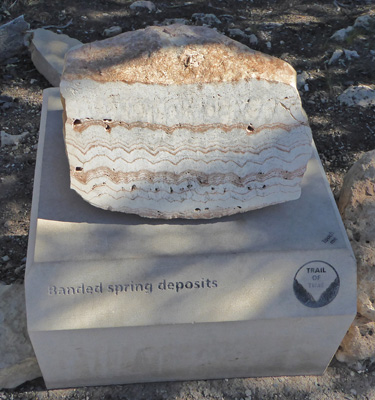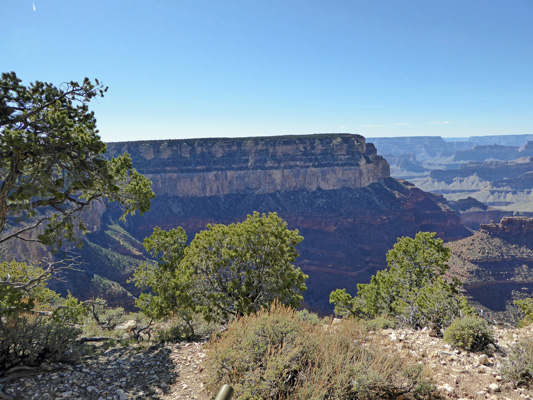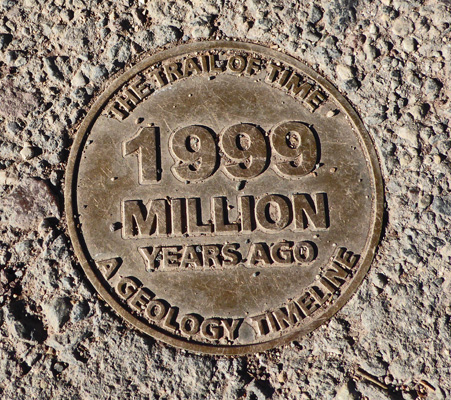Believe it or not the canyon itself is pretty young. The Colorado River only began to carve the canyon 5 or 6 million years ago. It has made a lot of progress in such a short time!
As you walk along the the trail they show you samples of the rocks in the layers corresponding to the time period you’re walking through. It starts with Banded spring deposits which you find at the top of the canyon. It relatively new rock.

Then you pass a sample of basalt since there was volcanic activity 1,000 to 100,000 years ago along the canyon.

Kaibab limestone is usually considered the top layer of most of the Grand Canyon. The rock in this layer is 270 mile years old. They are rocks formed from a time when shallow seas covered the area.

Toroweap sandstone is the next layer down. It is made up of river and sea deposits from 273 million years ago.

Coconino sandstone is 275 million years old. It was formed from sand dune deposits.

If you look across the canyon in this photo you can see the top 4 layers pretty clearly. The top layer is the Kaibab Formation at 270 million years old. The next layer is the Toroweap Formation at 273 million years old. The 3rd layer down (the wide white band) is Coconino Sandstone at 275 million years old. The 4th layer (the sloping darker layer) is the Hermit Formation which is 280 million years old.

Below that you can see the beginnings of the Supai Group which covers 285 to 315 million years ago. This group is comprised of layered Paleozoic Rocks that comprise the upper two thirds of the canyon's walls.
These rocks formed near sea level at the edge of the continent.
It includes Esplanade sandstone which is 285 million years old.

After the Supai Group comes Redwall Limestone at 340 million years old and Temple Butte Formation which is 385 million years old. There is then a gap where the rock layers were eroded away before new layers were deposited. So we lose 120 million years of record!
And then we come to the Tonto Group which includes Muav limestone which is 505 million years old.

And Bright Angel Shale which is 515 million years old.

And Tapeats sandstone at 525 million years old.

Next we come to the Grand Canyon Supergroup which is are only visible in a few places in the canyon. The strata of the Supergroup accumulated in basins formed as the land mass pulled apart (going back over a billion years ago). The expansion caused the blocks of the layers to tilt, inclining the layers. The youngest of the visible tilted layers is Sixtymile conglomerate at 650 million years old.

Followed by Awatubi limestone at 750 million years old.

And Carbon Butte sandstone at 760 million years old.

Duppa sandstone at 770 million years old

Carbon Canyon limestone at 780 million years old

Jupiter limestone at 790 million years old

Tanner limestone is 800 million years old

Nanloweap sandstone is 900 million years old

Shinumo sandstone is 1,170 million years old or 1 billion 170 million years.

Hakatai sandstone is 1,180 million years old

Bass limestone is 1,190 million years old

And the last of the Supergroup is Hotauta conglomerate which is 1,200 million years old.

They gave us a sample of Cremation pegmatite at 1,698 milion years old but it doesn't show up in any of the literature I've found so I would guess it is very hard to find in the canyon.

The same is true for Horn Creek granite at 1,713 million years old.

And Ruby gabbro at 1716 million years old.

Finally we come to what is known as the Vishnu Basement Rocks. These were all formed nearly 2 billion years ago when a tectonic plate carrying an island chain and the plate that became North America collided. The heat and pressure from this collision changed the existing rock layers into dark metmorphic rock--the basement of the canyon. Molten rock squeezed into cracks and hardened as light bands of granite.
This is a sample of Folded Vishnu basement rock.

Trinity granite has the same distinctive dark color. It is 1,730 million years old.

Diamond Creek granite has intrusions of lighter granite. It is 1736 million years old.

Zoraster granite is 1740 million years old.

Vishnu schist is 1745 million years old.

Brahma schist is 1750 million years old.

Rama schist has red intrusions and is 1755 million years old.

And finally we hit bottom as it were, with Elves Canyon gneiss which is the oldest rock visible in the canyon at 1840 million years old. While it was formed 1840 million years ago it was transformed into gneiss only 1700 million years ago.
While nearly 2 billion years sounds incredibly old it is only 2/5ths the age of the earth itself.

When you arrive at the end of the trail the last of the markers indicates that we've covered 1999 million years in our Trail of Time.

Here is a sign showing how the layers in the canyon work. The tilted layers in the middle are the Grand Canyon Supergroup. And the old fossil standing next to the sign is of course, wonderful Walter.

